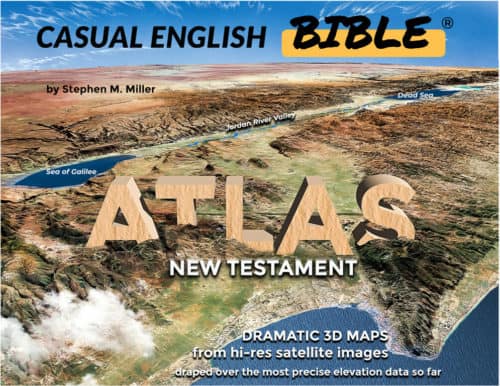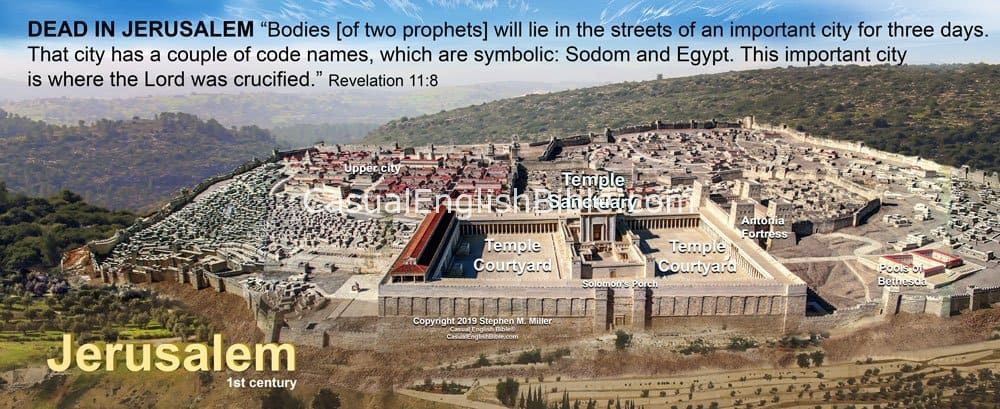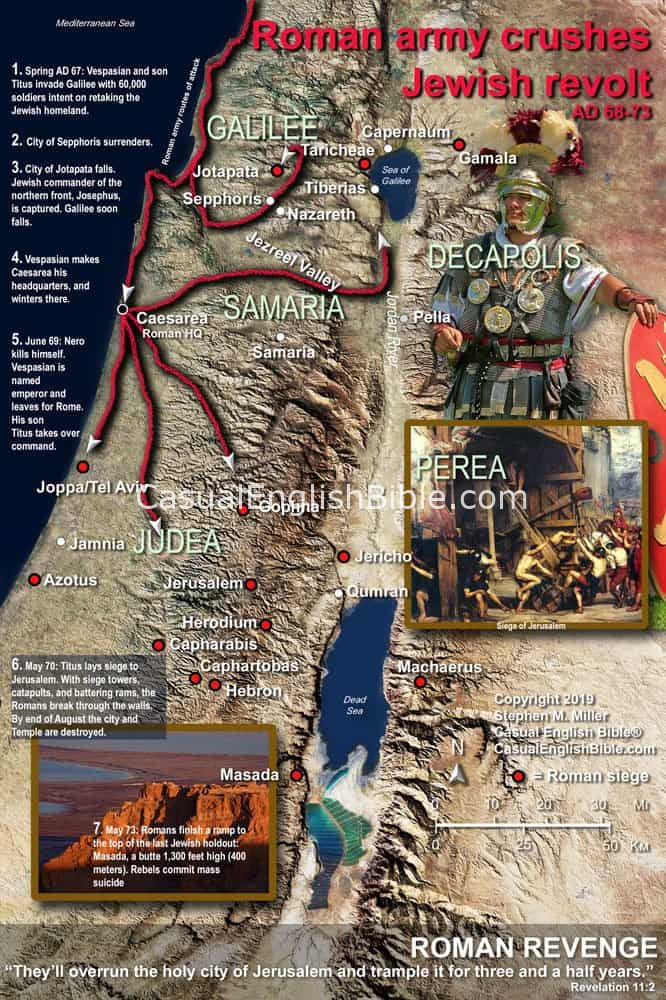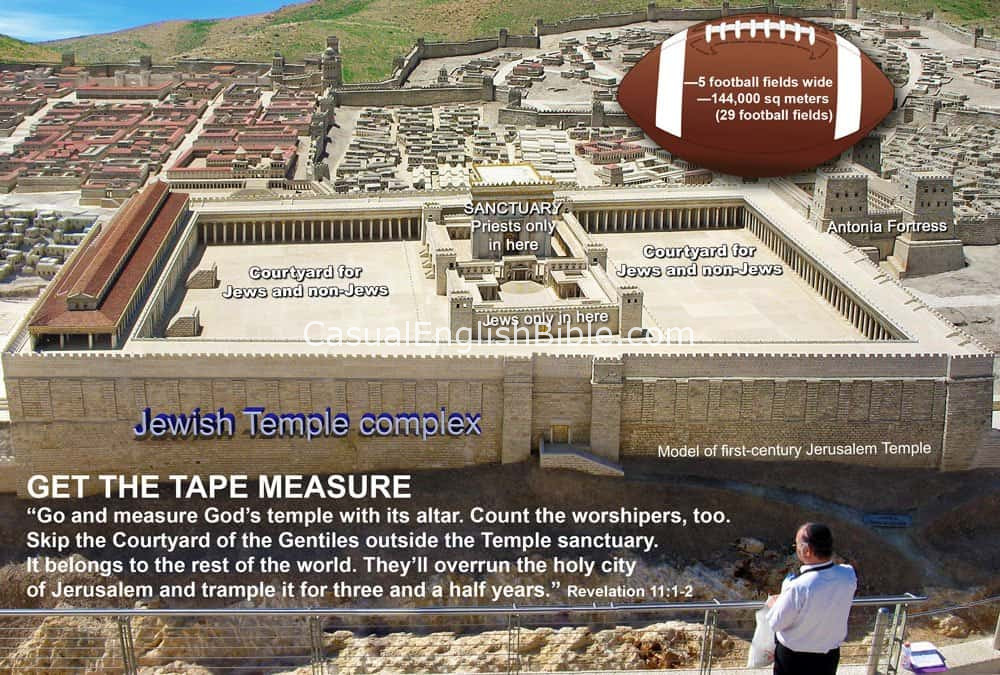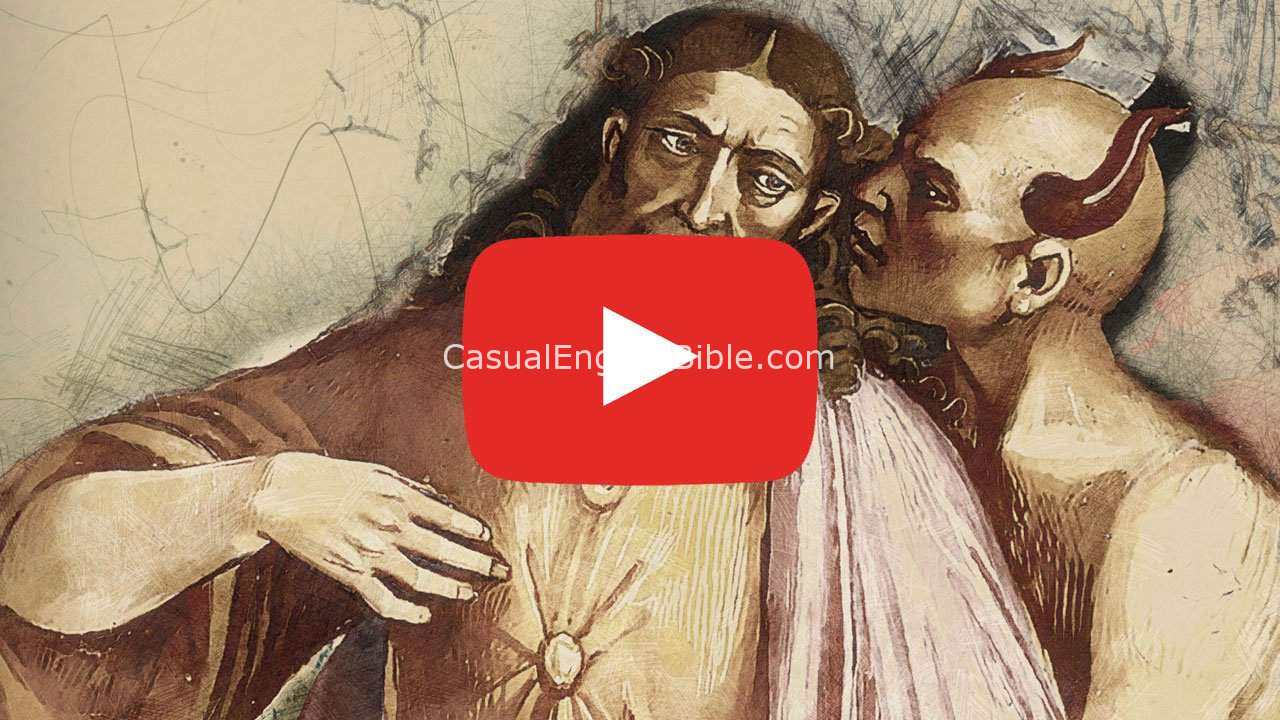Revelation 11
Prophets who don’t stay dead
Two Prophets, Three Days Dead and Rising
1Then someone gave me what looked like a walking stick with measurement markings on it. I got these instructions: “Go and measure God’s temple with its altar. Count the worshipers too. 2Skip the Courtyard of the Gentiles outside the temple sanctuary. It belongs to the rest of the world. They’ll overrun the holy city of Jerusalem and trample it for three and a half years. [1] 3I’m giving two of my witnesses [2] the authority to prophesy. They’ll wear clothes made from rough cloth traditionally associated with prophets. [3] And they’ll deliver my messages for 1,260 days.” [4]4These two prophets are the “two olive trees” [5] and the two menorah lampstands [6] that stand in the presence of the Lord who rules the earth. 5If anyone tries to hurt these witnesses, fire will fly. Fire will shoot out of the mouths of my witnesses, burning up their enemies. [7] If anyone tries to hurt them, this fire will kill the attacker. 6These two witnesses have the power to stop the rain while on this prophecy mission. [8] They can turn water into blood, as well. They can also use their discretion and strike the planet with any plague they want, as often as they want. [9]
7The two witnesses will give their testimony, delivering my message. When they’re done, the beast [10] from the abyss of punishment [11] will declare war on them, defeat them, and kill them. 8Their bodies will lie in the streets of an important city for three days. That city has a couple of code names, which are symbolic: Sodom and Egypt. [12] This important city is where the Lord was crucified. [13]
9No one wants to bury the two dead witnesses. So, their bodies lay in the street for three and a half days—on display for people everywhere, from every country, tribe, and language. 10When news gets out that the two witnesses are dead, the world celebrates. Some celebrate by passing out gifts. They’re happy because the two prophets had tormented them. Now both are dead and gone. 11Three and a half days dead, the witnesses come back to life. That’s because God breathed into them the breath of life. So, they stood up. That scared the dickens out of everyone who had been watching their corpses.
12Soon, both heard a loud voice from heaven telling them, “Come on up!” They started levitating. They rose off the ground and into a cloud that carried them to heaven. Their enemies saw it. 13Within the hour, an earthquake destroyed a tenth of the city, killing 7,000 people. Survivors were terrified. They reacted by acknowledging the powerful God in heaven. [14] 14The second terror is over. Up next, the finale.
Seventh Angel Blows Trumpet of Judgment
15When the seventh angel blew his trumpet, I heard loud voices in heaven. Together they said,“God’s kingdom has come.
This world belongs to our Lord and his Messiah.
The Lord’s in charge now. He’ll be in charge forever.”
“Thank you, Lord.
You are now and have always been Almighty God.
Today you invoke your authority
and begin ruling your entire kingdom.
But it’s time now to pass judgment. [15]
The dead will suffer the fury of this judgment too.
Time has come, as well, to reward your people,
the prophets, the devoted followers,
and those who respect you—famous and unknown.
It’s time to destroy those who destroy the people of this world.” 19Then I saw God’s temple in heaven. The doors opened. Inside I could see the chest that held the Ten Commandments. [16] Lightning flashed. Thunder rumbled. An earthquake shook the ground, as heavy hail rained through the sky.
Footnotes
Literally, 42 months. Some scholars say this refers to when Romans crushed a revolution Jews launched in AD 66, driving out the Romans. Roman armies returned in the spring of AD 67. Three and a half years later, they had overrun the Jewish homeland. By the fall of AD 70—three and a half years after their invasion—they had leveled the city of Jerusalem, along with the Temple.
The “two witnesses,” some scholars say, seem to represent Christians who defend their faith. They refuse to back down even when people threaten to kill them because of what they say. Other scholars offer their guesses about who the witnesses were or will be. A few guesses: Elijah and Jeremiah, John the Baptist and Jesus, Peter and Paul. Some suggest symbolic witnesses: Old Testament and New Testament, the prophets and the apostles, the written Word of God and the teaching of Jesus.
John the Baptist “wore clothes made from camel’s hair” (Matthew 3:4).
“1,260 days” is another way of saying 42 months/three and a half years (Revelation 11:2).
This seems linked to Zechariah 4:3. The setting there was the anointing of Zerubbabel as leader of the Jewish refugees returning to their homeland. And the hope the Jews had was in the promise of a coming future king. John may have understood the olive trees and lampstands in his vision as a metaphor revealing God’s commissioning of the two prophets.
Zechariah 4:2-3, 11 describes just one menorah lampstand with seven spouts for flames. But ancient pictures from ruins of synagogues, such as Beth Alpha, show two menorahs framing the ark cabinet that held the synagogue’s sacred scroll, the Torah.
This symbolizes the power of honest words spoken to lies, corruption, and tyranny. The prophet Jeremiah used fire in the mouth in a similar symbolic way: “My messages will flame out of your mouth and burn the people like kindling wood” (Jeremiah 5:14, New Living Translation).
For Jews who knew their Bible and the highlights of their history, a promise like this would remind them of the prophet Elijah. He stopped the rain in Israel for three and a half years.
This is like power God gave Moses in the 10 plagues of Egypt (Exodus 7—11). And then some. The witnesses could start a plague whenever they felt it necessary. Moses had to follow God’s specific instructions about what plague to launch and when to launch it.
John introduces one of the beasts of Revelation. He doesn’t say if this is the beast from the sea (Revelation 13:1-10), which some label as the “Antichrist” (a word John never uses, but see how it’s used in 1 John 2:18; 2 John 1:7). Another contender: the beast from the land (Revelation 13:11-18), which some link to Emperor Nero (see footnotes for Revelation 13:18). Daniel 7:3 predicted four animals that came from the sea. Daniel saw them in a vision. They represented kings. One more option: John was thinking of a third beast, in addition to the beast from the sea and the one from the land.
Also called the bottomless pit. Jews at the time taught that the abyss was the underworld—the place of the dead (Romans 10:7). Luke 8:31 presents it as the “home of demons” too. Scholars sometimes translate the word abyss as “bottomless pit.” It’s Satan’s thousand-year prison in Revelation 20:1-3. It’s also linked to the depths of the sea, something Luke may have had in mind when he reported the story of demons ending up in the Sea of Galilee after Jesus cast them into a herd of pigs (Luke 8:33).
When Bible writers needed to talk about sinful cities or nations, they sometimes mentioned Sodom, a city God torched off the planet (Genesis 19:24). They would also refer to Egypt, the nation that imprisoned the Jews before Moses led them to freedom.
Jerusalem
Literally, “gave glory to the God of heaven.” John doesn’t make it clear if the “glory” comes from a decision to change their ways and follow God or if it’s the begrudging admission that the other guy won.
Literally, “your wrath came.” The phrase “the wrath of the LORD” (Ezekiel 7:19, New American Standard Bible) shows up a lot in the Old Testament prophets, when they warned people to stop their incessant sinning.
The chest was known as the ark of the covenant (Exodus 25:10-22).
Discussion Questions
- 1
Sometimes it’s hard to tell if John is talking about the past or the future. Someone gave him the odd job of measuring the Temple with something that sounds like a yardstick. John is told not to bother with the courtyard, which is where non-Jews worship God. John is told that the non-Jews will “overrun the holy city of Jerusalem and trample it for three and a half years” (Revelation 11:2). That’s how long it took the Roman invaders to overrun one Jewish city after another before finally reaching Jerusalem and tearing it to the ground in AD 70. (See footnote for Revelation 11:2.) Do you think John is talking about what had happened then, several decades before he wrote this letter? Or do you think he’s talking about something else?
- 2
We don’t know who the “two witnesses” are who deliver God’s messages “for 1,260 days” (Revelation 11:3). Take a look at the theories that show up in the footnote for Revelation 11:3. What do you think about them?
- 3
Bible experts offer different theories about who the beast was who killed the two witnesses. Which of these theories do you think would make most sense to most people?
- The beast is anyone at war with God and the church. The two witnesses represent the long line of prophets, ending with John the Baptist. Many, like John the Baptist, delivered their message and died because of it.
- The beast is a future dictator working with a fraud religion leader and with Satan. They allow the two witnesses to preach for three and a half years, and then the beast executes them.
- The beast represents corrupt religion leaders throughout Christian history, including popes who denied a Christian burial to people they considered heretics. This tracks with “their bodies lay in the street” (Revelation 11:9).
- 4
Some people reading Revelation might find themselves particularly surprised by all the celebration that goes on when the seventh angel blows his trumpet of judgment. The world is about to end. And it’s going to end badly for some people, as John tells it. What do you make of the celebration and the loud voices in unison chanting, “Thank you, Lord” (Revelation 11:17)?
- 5
LIFE APPLICATION. It’s hard to imagine a world without sin. Even a Hallmark movie has a bad guy. Would you tell about a scene from your life or from the life of someone you know that represents the kind of experience you hope to have in the next life?





